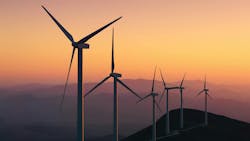Global Electricity Demand Reaches Record Levels as Renewable and Fossil Fuel Use Both Rise
The Energy Institute (EI), in partnership with Kearney and KPMG, released the 74th edition of the Statistical Review of World Energy, providing a comprehensive overview of global energy data for 2024.
The report highlights continued momentum in renewable energy, with wind and solar growing by 16% in 2024. China contributed 57% of new capacity additions, with its solar capacity nearly doubling over two years. Despite this growth, fossil fuel use also increased slightly — by just over 1% — driven by rising global energy demand, which reached an all-time high of 592 exajoules (EJ), up 2% from the previous year.
Electricity demand rose by 4%, outpacing overall energy demand and underscoring the increasing role of electrification across economies. The data shows that all major forms of energy — coal, oil, gas, renewables, hydro, and nuclear — reached record levels of consumption in 2024.
Emissions from energy use rose by 1%, the fourth consecutive annual increase, coinciding with a year in which average global temperatures frequently exceeded the 1.5°C threshold.
Oil demand remained stable in OECD countries but increased by 1% in non-OECD nations. Chinese oil consumption declined by 1.2%, suggesting 2023 may have marked a peak. Natural gas demand rebounded globally, rising by 2.5% after a downturn in 2023. Coal demand in India increased by 4%, bringing its consumption on par with that of the CIS, Southern and Central America, North America, and Europe combined.
While renewable energy deployment is growing rapidly, it is occurring alongside — rather than displacing — increases in fossil fuel use. This trend reflects the broader complexity of the global energy transition.
Energy Institute President Andy Brown OBE FEI said, “This year’s data reflects a complex picture of the global energy transition. Electrification is accelerating, particularly across developing economies where access to modern energy is expanding rapidly. However, the pace of renewable deployment continues to be outstripped by overall demand growth, 60% of which was met by fossil fuels. The result is a fourth consecutive year of record emissions, highlighting the structural challenges in aligning global energy consumption with climate goals.”
Dr. Nick Wayth CEng FEI, CEO of the Energy Institute, added, “All major energy sources, including nuclear and hydro, hit record consumption levels (for the first time since 2006), a reflection of surging global demand. No country has shaped this outcome more than China. Its rapid expansion of renewable capacity, alongside continued reliance on coal, gas, and oil, is driving global energy trends. The scale and direction of China’s energy choices will be pivotal in determining whether the world can deliver a secure, affordable, and low-carbon energy future.”
Dr. Romain Debarre, Partner and Managing Director, Energy Transition Institute, Kearney, commented, “Last year was another turning point for global energy, driven by rising geopolitical tensions. Energy security, resource access, and technological sovereignty are now taking priority over climate goals. This year’s data reveals three trends that are shaping the energy landscape: energy use is rising, but patterns are shifting; electrification is rapidly accelerating; and the energy transition remains chaotic.
“We are witnessing the real dangers of regional differences and the cost of inaction in real time. Record-high GHG emissions and soaring temperatures in 2024 are a deafening wake-up call. We have the strategies, technologies, and know-how to deliver the energy transition with an integrated, secure, and people-centred approach. Now, we must move from promises to action, at scale and at speed.”
Wafa Jafri, Lead of Energy and Natural Resources Strategy and Partner at KPMG in the UK, stated, “COP28 set out a bold vision to triple global renewables by 2030, but progress is proving uneven and despite the rapid growth we have seen globally we are still not at the pace required, as energy demand continues to rise. This year’s data highlights how Europe has been facing a reality check, with rising interest rates and supply chain costs slowing progress on renewables, while China and other emerging markets continue to drive growth at scale. What’s emerging is not a uniform transition, but a disorderly one.
"Leaders navigating this need to look beyond headlines and towards practical delivery, regional opportunity, and strategies built for resilience as all facets of the energy trilemma: affordability, security of supply and decarbonisation, compete for priority.”
